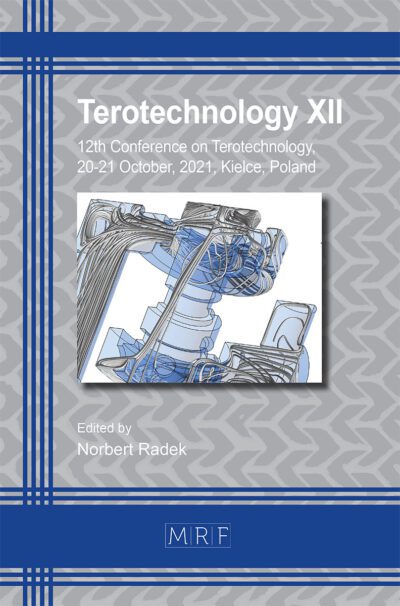Milling of titanium alloy: Effects of different lubrorefrigeration conditions on environmental impact
Mariateresa Caggiano, Maria Rosaria Saffioti, Serafino Caruso, Giovanna Rotella, Agata Sposato
Abstract. The use of cutting fluids in machining is crucial for optimizing process performance. In light of increasing environmental regulations, there is growing scrutiny on the role of cutting fluids in manufacturing processes. The adoption of environmentally-friendly approaches in metal cutting holds significant economic, social and technological implications. This paper focuses on the milling operation of a non-conventional material, such as Ti-alloy, from an environmental perspective, examining the material removal process across various performance aspects. Specifically, three different cooling conditions – wet, Minimal Quantity Lubrication (MQL), and dry – are assessed. Additionally, for each coolant condition, a range of process parameters, including cutting speed and feed rate, are considered to evaluate their impact on the overall environmental performance of the operation.
Keywords
Milling Process, Metalworking Fluids, Sustainable Production
Published online 5/7/2025, 9 pages
Copyright © 2025 by the author(s)
Published under license by Materials Research Forum LLC., Millersville PA, USA
Citation: Mariateresa Caggiano, Maria Rosaria Saffioti, Serafino Caruso, Giovanna Rotella, Agata Sposato, Milling of titanium alloy: Effects of different lubrorefrigeration conditions on environmental impact, Materials Research Proceedings, Vol. 54, pp 1720-1728, 2025
DOI: https://doi.org/10.21741/9781644903599-185
The article was published as article 185 of the book Material Forming
![]() Content from this work may be used under the terms of the Creative Commons Attribution 3.0 license. Any further distribution of this work must maintain attribution to the author(s) and the title of the work, journal citation and DOI.
Content from this work may be used under the terms of the Creative Commons Attribution 3.0 license. Any further distribution of this work must maintain attribution to the author(s) and the title of the work, journal citation and DOI.
References
[1] F. Borda, A.M.I. Cosma, L. Filice, Enabling Industry 4.0 Transformation in Calabria region: Framework, Machine Interconnection and ERP Synergy, Procedia Computer Science, (232) (2024), 1151-1163. https://doi.org/10.1016/j.procs.2024.01.113
[2] F. Borda, A. D. La Rosa, L. Filice, F. Gagliardi, Environmental comparison of opposing manufacturing strategies at changing of energy sources, EoL approaches and shape peculiarity for an automotive component, Advances in Materials and Processing Technologies, (2024), 1–21. https://doi.org/10.1080/2374068X.2024.2432724
[3] S. Caruso, E. Sgambitterra, S. Rinaldi, A. Gallone, L. Viscido, L. Filice, D. Umbrello, Experimental comparison of the MIG, friction stir welding, cold metal transfer and hybrid laser-MIG processes for AA 6005-T6 aluminium alloy, AIP Conf. Proc., (1769) (2016), 100004. https://doi.org/10.1063/1.4963498
[4] S. Caruso, S. Imbrogno, G. Rotella, M. I. Ciaran, P. J. Arrazola, L. Filice, D. Umbrello, Numerical Simulation of Surface Modification During Machining of Nickel-based Superalloy, Procedia CIRP, (31) (2015), 130-135, https://doi.org/10.1016/j.procir.2015.03.053
[5] Z.W. Pu, S. Caruso, D. Umbrello, Jr O.W. Dillon, D.A. Puleo, I.S. Jawahir, Analysis of surface integrity in dry and cryogenic machining of AZ31B Mg alloys. Adv. Mater. Res. 223 (2011) 439-448. https://doi.org/10.4028/www.scientific.net/AMR.223.439
[6] G. Rotella, S. Caruso, A. Del Prete, L. Filice, Prediction of Surface Integrity Parameters in Roller Burnishing of Ti6Al4V, Metals, 10(12) (2020), 1671. https://doi.org/10.3390/met10121671
[7] G. Rotella, C. Morano, M. R. Saffioti, D. Umbrello, Surface functionalization of titanium screws for orthopaedic implant applications, CIRP Annals, 73(1) (2024), 453-456. https://doi.org/10.1016/j.cirp.2024.04.095
[8] G. Rotella, F. Cosco, M.R. Saffioti, D. Umbrello, Evaluation of fretting corrosion fatigue in burnishing of Ti6Al4V component for artificial hip joint, CIRP Annals, 72(1) (2023), 509-512. https://doi.org/10.1016/j.cirp.2023.04.010
[9] M. Sanguedolce, G. Rotella, M.R. Saffioti, L. Filice, Burnishing of AM Materials to Obtain High Performance Part Surfaces, Journal of Industrial Engineering and Management, 15(1) (2022), 92-102. https://doi.org/10.3926/jiem.3608
[10] M.R. Saffioti, G. Rotella, D. Umbrello, Superfinishing processes applied on the biomedical implants surface to improve their performance, Materials Research Proceedings (28) (2023), 1341-1346. https://doi.org/10.21741/9781644902479-145
[11] F. Pusavec, P. Krajnik, J. Kopac, Transitioning to sustainable production – Part I: application on machining technologies, J Clean Prod, 18(2) (2010), 174–184. https://doi.org/10.1016/j.jclepro.2009.08.010
[12] J. C. Williams, R. R. Boyer, Opportunities and Issues in the Application of Titanium Alloys for Aerospace Components, Metals (Basel), 10(6) (2020), 705. https://doi.org/10.3390/met10060705
[13] E. A. Loria, Gamma titanium aluminides as prospective structural materials, Intermetallics (Barking), 8(9–11) (2000) 1339–1345. https://doi.org/10.1016/S0966-9795(00)00073-X
[14] A. D. Jayal, A. K. Balaji, Tribological and Thermal Effects of Cutting Fluid Application in Machining With Coated and Grooved Cutting Tools, in Manufacturing Engineering and Materials Handling, Parts A and B, ASMEDC, (2005), 513–520. https://doi.org/10.1115/IMECE2005-82963
[15] A. A. Munoz, P. Sheng, An analytical approach for determining the environmental impact of machining processes, J Mater Process Technol, 53(3–4) (1995), 736–758. https://doi.org/10.1016/0924-0136(94)01764-R
[16] M. F. Rajemi, P. T. Mativenga, A. Aramcharoen, Sustainable machining: selection of optimum turning conditions based on minimum energy considerations, J Clean Prod, 18(10–11) (2010), 1059–1065. https://doi.org/10.1016/j.jclepro.2010.01.025
[17] S. Debnath, M. M. Reddy, Q. S. Yi, Environmental friendly cutting fluids and cooling techniques in machining: a review, J Clean Prod, 83, (2014), 33–47, doi: 10.1016/j.jclepro.2014.07.071
[18] K. C. Wickramasinghe, H. Sasahara, E. A. Rahim, G. I. P. Perera, Green Metalworking Fluids for sustainable machining applications: A review, J Clean Prod, 257 (2020), 120552. https://doi.org/10.1016/j.jclepro.2020.120552
[19] P. C. Priarone, S. Rizzuti, G. Rotella, L. Settineri, Technological and Environmental Aspects in Milling of γ-TiAl, Adv Mat Res, 223 (2011), 340–349. https://doi.org/10.4028/www.scientific.net/AMR.223.340
[20] K. Weinert, I. Inasaki, J. W. Sutherland, T. Wakabayashi, Dry Machining and Minimum Quantity Lubrication, CIRP Annals, 53(2) (2004), 511–537. https://doi.org/10.1016/S0007-8506(07)60027-4












